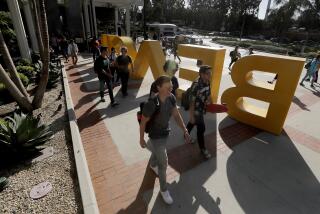Focusing on Community Colleges
- Share via
The new state Commission for the Review of the Master Plan for Higher Education will start its deliberations soon and, by legislative directive, must focus during its first year on community colleges. It’s not a moment too soon, given sharply declining enrollments and barely adequate budgets for these two-year campuses.
Enrollment figures represent one starting point for discussion, especially if the commission can maintain an analytical air in its assessment rather than resorting to partisan polemics. It’s too easy to blame the recent declines on the $50 fee imposed last fall and then go no further. The commission should also consider whether the recent decline in enrollment is a natural sign of the demographic times, a function of outside forces or perhaps a symptom that something is lacking on the campuses themselves.
The figures are indeed alarming. In Los Angeles alone, enrollment for the spring term is down by more than 19,000 students, or 18% since last spring.
Those figures don’t tell the whole story because the enrollment decline actually began before the fee was imposed. A recent report from the California Postsecondary Education Commission points out that enrollment dropped off by 4.9% in the fall of 1982. That decline reflects mainly older, part-time students who had been taking the recreational courses that lost state financial support that year.
But the next year’s enrollment fell as well, with 114,00 fewer students, or 8.4%, registering in the fall of 1983 than had signed up for courses the previous year. For the first time, the losses were heavy among 18- and 19-year-olds and black and Latino students. The researchers speculated that there were many reasons for these declines--including an upturn in the economy, increased military recruitment efforts, and changes in registration processes that favored students already enrolled. But they added that the causes did not include any substantial drop in the number of high-school graduates or any great shift to other colleges in California.
These enrollment losses will have an effect for more than one year. The younger students are the ones who usually attend classes full time in academic or vocational programs, and it is on that attendance that state funding is determined. Community colleges may therefore be in a financial decline that will be difficult to stop. In addition, there will be fewer students available to transfer to the state’s four-year universities, so those campuses may also suffer enrollment drops as early as next fall. Finally, there is also the concern that minority youths are losing out at the very campuses that have typically been their main points of entry into higher education in California.
People have talked for years about “redefining the mission of the community colleges.” Now there is some urgency to the need for redefinition. The state needs to be sure that its money is being spent in line with its overall goals for higher education, and students deserve assurance that their needs will be met if they do enroll.
More to Read
Sign up for Essential California
The most important California stories and recommendations in your inbox every morning.
You may occasionally receive promotional content from the Los Angeles Times.













